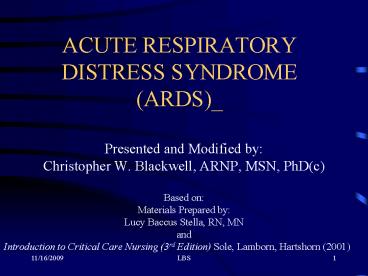ACUTE RESPIRATORY DISTRESS SYNDROME ARDS_ - PowerPoint PPT Presentation
1 / 26
Title:
ACUTE RESPIRATORY DISTRESS SYNDROME ARDS_
Description:
Introduction to Critical Care Nursing (3rd Edition) Sole, Lamborn, ... Diaphoresis. Crackles, Rhonchi, and Bronchial Sounds. Vitals Signs. Fever. Hypotension ... – PowerPoint PPT presentation
Number of Views:431
Avg rating:3.0/5.0
Title: ACUTE RESPIRATORY DISTRESS SYNDROME ARDS_
1
ACUTE RESPIRATORY DISTRESS SYNDROME (ARDS)_
- Presented and Modified by
- Christopher W. Blackwell, ARNP, MSN, PhD(c)
- Based on
- Materials Prepared by
- Lucy Baccus Stella, RN, MN
- and
- Introduction to Critical Care Nursing (3rd
Edition) Sole, Lamborn, Hartshorn (2001)
2
Definition
- Noncardiac pulmonary edema
- A form of respiratory failure
- Complication of hospitalized patients
- Serious med-surg problem
- May not be lung related
- Mortality remains 50-60
3
Pathophysiology
- Frequently associated
- Low perfusion
- Single organ
- Multi-organ (MODS)
- Total body system (shock)
- Etiology Severe CNS Disorder, Trauma, CVA, Inc.
CSF. - Hallmark of ARDS
- Hypoxia
4
Pathophysiology
- Other characteristics
- Severe dyspnea
- Diffuse bilateral infiltrates
5
Pathophysiology
- Injury to lungs (Scoring)
- Abnormal gas exchange
- Intrapulmonary shunting
- Reduced lung compliance
- Decreased surfactant activity
- Amt. of Infiltrates on CXR.
- Degree of Hypoxemia.
- Amount of PEEP.
- Static Lung Compliance.
6
Pathophysiology
- Physiologic alterations
- Injury to pulmonary endothelium and alveolar
epithelium causes increase in lung permeability. - Fluid leaks into interstitial spaces causing
pulmonary edema. - INCIDENCE AND PREVALENCE
7
Pathophysiology
- Physiologic alterations
- Injury to Type II pneumocytes, causes increase in
surface tension and atelectasis - Alveolar-capillary membrane damage, inflammation
occurs, substances gather at site of injury
decreasing gas exchange
8
Pathophysiology
- American-European Consensus Conference (1994)
Defines ARDS as - PaO2/FiO2 lt200
- Bilat. Infiltrates
- PCWP lt18mm Hg (or more easily understood, no
clinical evidence of L Atrial HTN).
9
Pathophysiology
- Results of physiologic alterations
- Ventilation-perfusion anomalies
- Decreased lung compliance
- Increase work of breathing
10
Etiology
- No single exogenous or endogenous precipitating
factor? Multiple causes. - Exact causative mechanism is unknown
- Direct and Indirect Causes
11
Etiology
- Many conditions associated
- Most common
- Non pulmonary
- Gram (-) sepsis
- Trauma
- Pulmonary related
- Aspiration
- AIDS/PCP
- Near drowning
- Pulmonary embolism
12
Etiology
- Other conditions
- Amniotic fluid embolism
- Bowel infarction
- Drug abuse
- Multiple fractures
- Heat stroke
- Peritonitis
- Multiple blood transfusions
13
Clinical manifestations
- Acute respiratory failure
- Change in Personality, disorientation, dec. LOC.
- Initial Dyspnea w/ Hyperventilation (Tachypnea)
- Grunting respirations
- Cyanosis
- Pallor
- Retractions
14
Clinical manifestations
- Dry cough
- Diaphoresis
- Crackles, Rhonchi, and Bronchial Sounds.
- Vitals Signs
- Fever
- Hypotension
- Tachycardia (dysrhythmias)
- Altered sensorium
- PaCO2 dec.? Resp. Alkalosis (initial)
- Lactic Acid? Met. Acidosis (later)
15
Diagnostic studies
- Radiologic
- CXR
- Diffuse, bilateral infiltrates
- Laboratory
- ABGs
- Hypoxemia
- Respiratory alkalosis
16
Phases of ARDS
- Phase I
- Client exhibits dyspnea and tachypnea
- Support client with oxygenation
- Phase 2
- Increasing pulmonary edema
- Mechanical ventilation support
17
Phases of ARDS
- Phase 3
- Progressive refractory hypoxemia
- Maintain oxygenation
- Prevent complications
- Phase 4
- Pulmonary fibrosis pneumonia
- Chronic problem
- Maybe ventilator dependent
18
Management
- Vent. Settings should be Lung-Protective.
- Unconventional Modes (High Frequency Ventilation,
Pressure-Controlled Ventilation, and
Inverse-Ratio Ventilation) have failed to
demonstrate efficacy and are not standard
acceptable Tx.
19
Nursing diagnosis
- Anxiety
- Impaired gas exchange
- Altered nutrition
- Depression
- Decreased cardiac output
- Knowledge deficit
20
Interventions
- Assess
- Sputum production
- Oxygenation
- Heart sounds
- Lung sounds
- Urinary output
- Cardiac rhythm
21
Interventions
- Monitor
- ABGs
- Pulse oximetry
- Ventilator settings
- Fluid maintenance
- Teach
- Ventilator
- Lines
22
Medical management
- Ventilator
- IMV
- PEEP
- Fluid control
- Swan Ganz line
23
Medical management
- Medications
- Diuretics
- Anti anxiety
- Neuromuscular blocking agents
- Analgesics
- Antibiotics
- Dopamine
- Corticosteroids
24
Nursing Management
- Possible Prone Positioning (Vollman, 1997).
- F/E Balancing Monitor R Arterial Pressure (RAP)
and Pulmonary Artery Diastolic (PAD) Pressure. - Nutrition ARDS increases nutritional
requirements by 1.5 to 2 times.
25
Nursing Management
- Psychosocial Support
- Complications of ARDS
- 1. Heart failure
- 2. Acidosis
- 3. Hyper- hypo- kalemia
- 4. De- over- hydration
- 5. Pulmonary embolism
26
Nursing Management
- Cardiac arrest
- DIC
- GI bleed
- Renal failure
- Prognosis
- Pts. Who recover typically return to
relatively normal lung function. Studies of ARDS
survivors from 9 months- 4 years after lung
injury show a mild restrictive pulmonary function.

